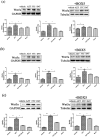Nucleoside reverse transcriptase inhibitors (NRTIs) induce proinflammatory cytokines in the CNS via Wnt5a signaling
- PMID: 28646196
- PMCID: PMC5482870
- DOI: 10.1038/s41598-017-03446-w
Nucleoside reverse transcriptase inhibitors (NRTIs) induce proinflammatory cytokines in the CNS via Wnt5a signaling
Abstract
HAART is very effective in suppressing HIV-1 replication in patients. However, patients staying on long-term HAART still develop various HIV-associated neurological disorders, even when the viral load is low. The underlying pathogenic mechanisms are largely unknown. Emerging evidence implicated that persistent neuroinflammation plays an important role in NeuroAIDS. Although residual virus or viral proteins are commonly thought as the causal factors, we are interested in the alternative possibility that HAART critically contributes to the neuroinflammation in the central nervous system (CNS). To test this hypothesis, we have determined the effect of NRTIs on the expression of proinflammatory cytokines in the various CNS regions. Mice (C57Bl/6) were administered with AZT (Zidovudine 100 mg/kg/day), 3TC (Lamivudine 50 mg/kg/day) or D4T (Stavudine 10 mg/kg/day) for 5 days, and cortices, hippocampi and spinal cords were collected for immunoblotting. Our results showed that NRTI administration up-regulated cytokines, including IL-1β, TNF-α and IL-6 in various CNS regions. In addition, we found that NRTIs also up-regulated Wnt5a protein. Importantly, BOX5 attenuated NRTI-induced cytokine up-regulation. These results together suggest that NRTIs up-regulate proinflammatory cytokines via a Wnt5a signaling-dependent mechanism. Our findings may help understand the potential pathogenic mechanisms of HAART-associated NeuroAIDS and design effective adjuvants.
Conflict of interest statement
The authors declare that they have no competing interests.
Figures





Similar articles
-
Quercetin attenuates AZT-induced neuroinflammation in the CNS.Sci Rep. 2018 Apr 18;8(1):6194. doi: 10.1038/s41598-018-24618-2. Sci Rep. 2018. PMID: 29670213 Free PMC article.
-
Nucleoside Reverse Transcriptase Inhibitors (NRTIs) Induce Pathological Pain through Wnt5a-Mediated Neuroinflammation in Aging Mice.J Neuroimmune Pharmacol. 2018 Jun;13(2):230-236. doi: 10.1007/s11481-018-9777-6. Epub 2018 Feb 10. J Neuroimmune Pharmacol. 2018. PMID: 29429030 Free PMC article.
-
Wingless-type mammary tumor virus integration site family, member 5A (Wnt5a) regulates human immunodeficiency virus type 1 (HIV-1) envelope glycoprotein 120 (gp120)-induced expression of pro-inflammatory cytokines via the Ca2+/calmodulin-dependent protein kinase II (CaMKII) and c-Jun N-terminal kinase (JNK) signaling pathways.J Biol Chem. 2013 May 10;288(19):13610-9. doi: 10.1074/jbc.M112.381046. Epub 2013 Mar 28. J Biol Chem. 2013. PMID: 23539626 Free PMC article.
-
Mutational patterns in the HIV genome and cross-resistance following nucleoside and nucleotide analogue drug exposure.Antivir Ther. 2001;6 Suppl 3:25-44. Antivir Ther. 2001. PMID: 11678471 Review.
-
The cellular pharmacology of nucleoside- and nucleotide-analogue reverse-transcriptase inhibitors and its relationship to clinical toxicities.Clin Infect Dis. 2004 Mar 1;38(5):743-53. doi: 10.1086/381678. Epub 2004 Feb 18. Clin Infect Dis. 2004. PMID: 14986261 Review.
Cited by
-
Drosophila model of anti-retroviral therapy induced peripheral neuropathy and nociceptive hypersensitivity.Biol Open. 2021 Jan 27;10(1):bio054635. doi: 10.1242/bio.054635. Biol Open. 2021. PMID: 33504470 Free PMC article.
-
Pathogenesis of HIV-associated depression: contributing factors and underlying mechanisms.Front Psychiatry. 2025 Apr 17;16:1557816. doi: 10.3389/fpsyt.2025.1557816. eCollection 2025. Front Psychiatry. 2025. PMID: 40313235 Free PMC article. Review.
-
Quercetin attenuates AZT-induced neuroinflammation in the CNS.Sci Rep. 2018 Apr 18;8(1):6194. doi: 10.1038/s41598-018-24618-2. Sci Rep. 2018. PMID: 29670213 Free PMC article.
-
Progress in Pathological and Therapeutic Research of HIV-Related Neuropathic Pain.Cell Mol Neurobiol. 2023 Oct;43(7):3343-3373. doi: 10.1007/s10571-023-01389-7. Epub 2023 Jul 20. Cell Mol Neurobiol. 2023. PMID: 37470889 Free PMC article.
-
Crocin Alleviates Pain Hyperalgesia in AIA Rats by Inhibiting the Spinal Wnt5a/β-Catenin Signaling Pathway and Glial Activation.Neural Plast. 2020 Jan 11;2020:4297483. doi: 10.1155/2020/4297483. eCollection 2020. Neural Plast. 2020. PMID: 32399022 Free PMC article.
References
-
- HIV/AIDS global situation and trends. http://www.who.int/gho/hiv/en (2015).
Publication types
MeSH terms
Substances
Grants and funding
LinkOut - more resources
Full Text Sources
Other Literature Sources

